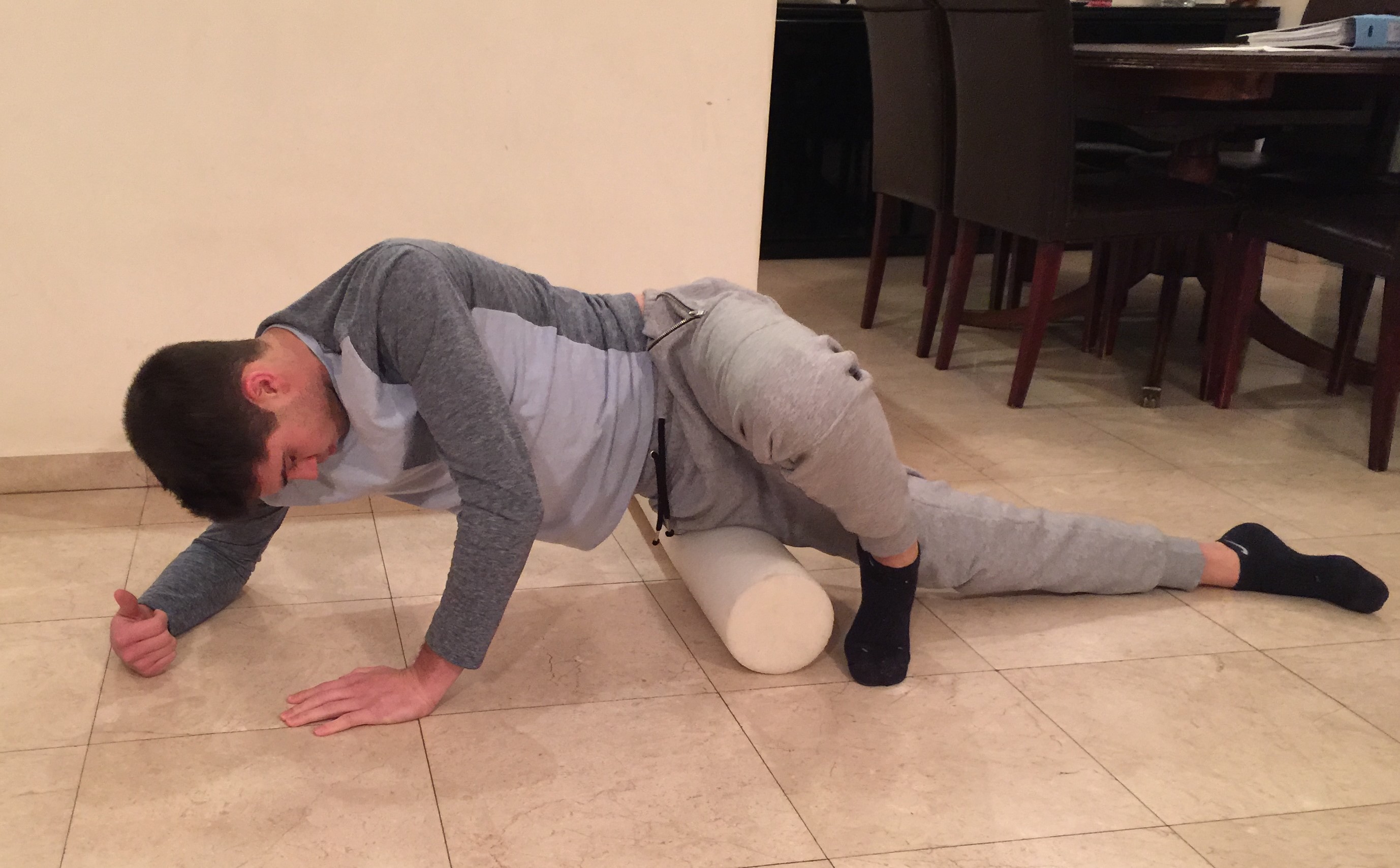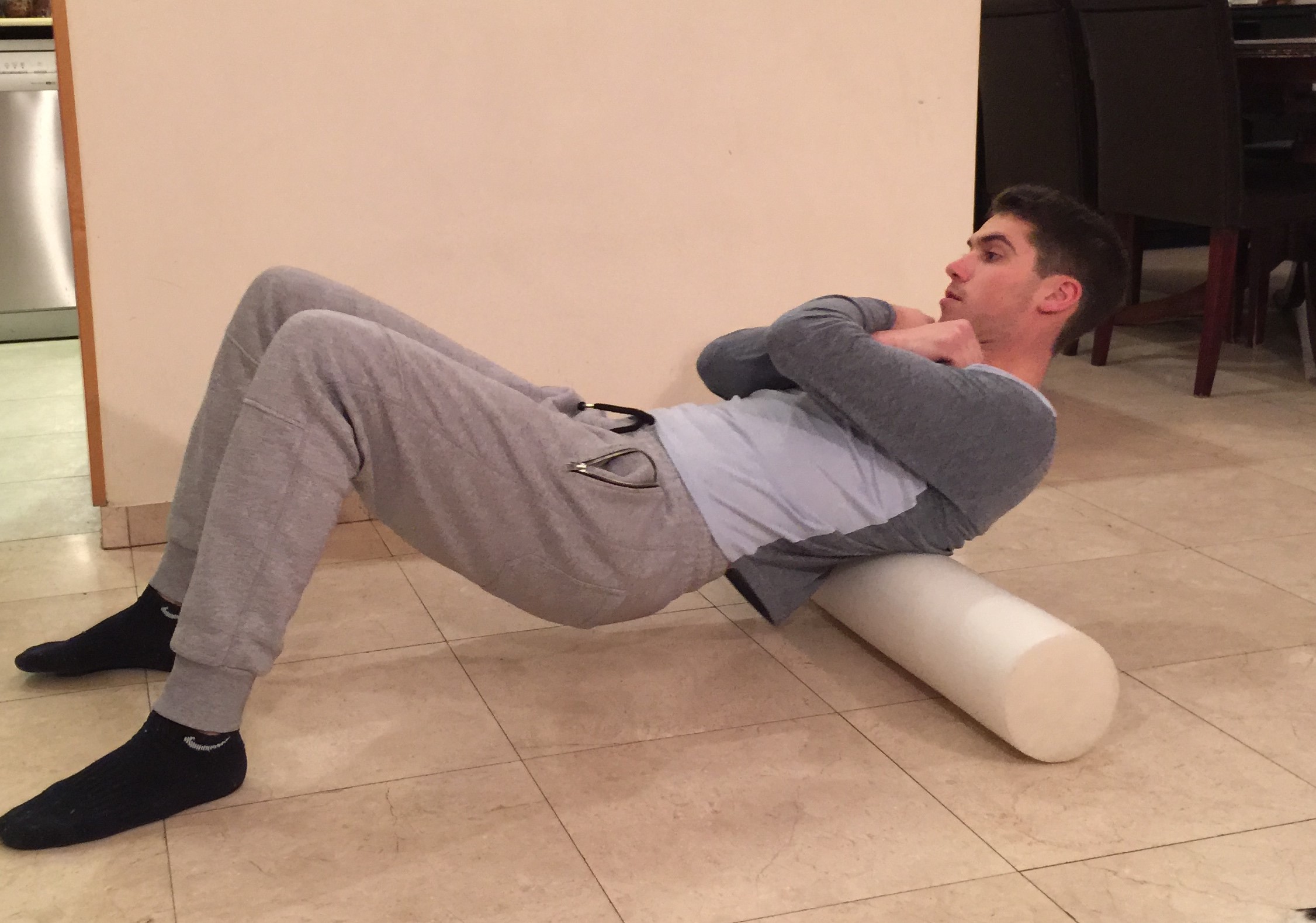My house guest is a recently graduated kinesiology student. Four days after arriving in Israel, he is still sore from squeezing his 1.90 plus meter frame into an airplane seat for 12 hours. He is very aware of what happens to his posture when he tightens up. If you have tight muscles, he tells me, it can affect everything. He knows that when his hamstrings tighten up they pull down his hips causing him to lose his lumbar curve, thereby negatively affecting his back. His standing posture is terrific, but the postures typical of a student’s lifestyle are pretty damaging. When I mention that I have a foam roller, he knows just how to use it to loosen up his muscles. It takes him about 20 minutes to work the tightness out of the large muscle groups. He knows how to use a foam roller safely. Before you begin a regimen with a foam roller, it’s necessary to ask your chosen sports or medical professional what is safe for you.
GLUTEUS MEDIUS. EXTRA BENEFIT: THE SPINE IS GETTING A NICE TWIST TOO
 The rolling begins by working the tightness out of the gluteus medius. The principle of the workout with the foam roller is the same for the entire body. Use slow, controlled movements. Don’t use the foam roller like a rolling pin. You can cause damage to the muscles and underlying tissue via bruising if you roll too fast or hard.
The rolling begins by working the tightness out of the gluteus medius. The principle of the workout with the foam roller is the same for the entire body. Use slow, controlled movements. Don’t use the foam roller like a rolling pin. You can cause damage to the muscles and underlying tissue via bruising if you roll too fast or hard.
STRETCHING OUT THE QUADRICEPS
 Like with all stretches, the movements are slow and controlled. If you feel tenderness, you stop where you are and take deep breaths, until you feel the referred pain lessen. Tenderness is okay to work through; pain is not.
Like with all stretches, the movements are slow and controlled. If you feel tenderness, you stop where you are and take deep breaths, until you feel the referred pain lessen. Tenderness is okay to work through; pain is not.
EXTRA BENEFITS: Working your arms and stretching out the hip flexors by lowering your pelvis to extend your hips are the extra benefits of this position. It’s a good idea to put a mat or carpet under your arms to avoid discomfort. By shifting the amount of weight on your arms, you affect the force of the roller on your quads. If you feel too much pain in your quads, transfer more weight to your arms. Since you are in plank position, your core muscles are being worked as well.
STRETCHING THE HAMSTRINGS
 In the one or two legged hamstring stretch, the arms are getting a nice workout and the core muscles are engaged. Tight hamstrings are the main weakness of our kinesiology graduate, so he will want to spend some extra time here. Starting with one leg at a time, and then rolling both legs at once is a nice way to spend some extra time on the hamstrings. By pointing your foot towards/away from the mid-line, you will work different parts of this muscle.
In the one or two legged hamstring stretch, the arms are getting a nice workout and the core muscles are engaged. Tight hamstrings are the main weakness of our kinesiology graduate, so he will want to spend some extra time here. Starting with one leg at a time, and then rolling both legs at once is a nice way to spend some extra time on the hamstrings. By pointing your foot towards/away from the mid-line, you will work different parts of this muscle.
THE IT BAND STRETCH
 The iliotibial band is stretched out only after all the muscles around it have been warmed up. This is because the IT band is a tendon and while it may appear as the main cause of tightness, the adjacent muscles are usually the culprits. It is safe to roll the IT band only after the other muscles have been rolled out and released.
The iliotibial band is stretched out only after all the muscles around it have been warmed up. This is because the IT band is a tendon and while it may appear as the main cause of tightness, the adjacent muscles are usually the culprits. It is safe to roll the IT band only after the other muscles have been rolled out and released.
STRETCHING OUT THE BACK
 Stretching out the back with the foam roller is limited to the area of the rib cage. Activating your core muscles takes some strain off your neck. The area of the kidneys is avoided.
Stretching out the back with the foam roller is limited to the area of the rib cage. Activating your core muscles takes some strain off your neck. The area of the kidneys is avoided.
After working out his muscle tightness on the foam roller, the kinesiology graduate feels more flexible and his back hurts him less. It is absolutely necessary to find the antidote to the static lifestyle that works for you. Before you begin, make sure your choice is a safe one for you to practice.



 I have been helping people to sit and move comfortably since 1998. I am always looking for ways to help people improve their relationships with their bodies.
I have been helping people to sit and move comfortably since 1998. I am always looking for ways to help people improve their relationships with their bodies.